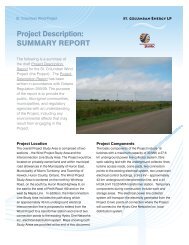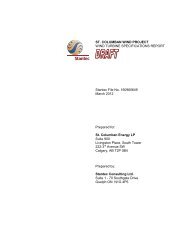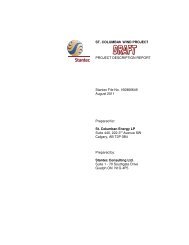Financial Report - Veresen Inc.
Financial Report - Veresen Inc.
Financial Report - Veresen Inc.
You also want an ePaper? Increase the reach of your titles
YUMPU automatically turns print PDFs into web optimized ePapers that Google loves.
The following table summarizes our financial instrument carrying and fair values as at December 31, 2011:<br />
<strong>Financial</strong><br />
<strong>Financial</strong><br />
assets at liabilities at Nonamortized<br />
amortized financial Fair<br />
cost cost instruments Total value (1)<br />
Assets<br />
Cash and short-term investments 21.9 21.9 21.9<br />
Restricted cash 354.6 354.6 354.6<br />
Distributions receivable 43.4 43.4 43.4<br />
Receivables and accrued receivables 32.3 32.3 32.3<br />
Due from jointly-controlled businesses 29.1 29.1 29.1<br />
Other assets 0.8 14.6 15.4 0.8<br />
Liabilities<br />
Payables and accrued payables 57.1 2.4 59.5 57.1<br />
Subscriptions receipts payable 348.6 348.6 348.6<br />
Dividends payable 2.7 2.7 2.7<br />
Senior debt 765.6 765.6 803.3<br />
Subordinated convertible debentures 86.2 86.2 94.0<br />
Other long-term liabilities 7.2 27.8 35.0 7.2<br />
(1) Fair value excludes non-financial instruments.<br />
For the years ended December 31, 2012 and 2011 the following amounts were recognized in income:<br />
2012 2011<br />
Total interest expense, recorded with respect to other financial liabilities, calculated using the effective rate method 58.6 45.9<br />
Fair Values<br />
Fair value is the amount of consideration that would be agreed upon in an arm’s length transaction between knowledgeable, willing<br />
parties who are under no compulsion to act.<br />
The fair values of financial instruments included in cash and short-term investments, restricted cash, distributions receivable,<br />
receivables and accrued receivables, due from jointly-controlled businesses, other assets, payables and accrued payables, dividends<br />
payable, subscription receipts payable, and other long-term liabilities approximate their carrying amounts due to the nature of the item<br />
and/or the short time to maturity. The fair values of senior debt are calculated by discounting future cash flows using discount rates<br />
estimated based on government bond rates plus expected spreads for similarly rated instruments with comparable risk profiles. The fair<br />
values of subordinated convertible debentures are measured at quoted market prices.<br />
US GAAP establishes a fair value hierarchy that distinguishes between fair values developed based on market data obtained from<br />
sources independent of the reporting entity, and fair values developed using the reporting entity’s own assumptions based on the<br />
best information available in the circumstances. The levels of the fair value hierarchy are:<br />
Level 1: Inputs are quoted prices (unadjusted) in active markets for identical assets or liabilities.<br />
Level 2: Inputs are other than the quoted prices included in Level 1 that are observable for the asset or liability, either directly or indirectly.<br />
Level 3: Inputs are not based on observable market data.<br />
<strong>Financial</strong> instruments measured at fair value as of December 31, 2012 were:<br />
Level 1 Level 2 Level 3 Total<br />
Cash and short-term investments 16.1 16.1<br />
Restricted cash 5.8 5.8<br />
61









